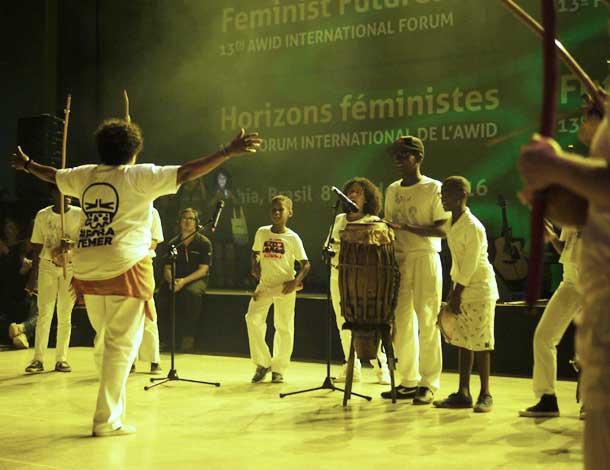Brazil’s centuries-old tradition of protest through the martial art is seeing a resurgence as capoeiristas demonstrate against Temer’s regime.
Capoeira has been used as a tool of resistance in Brazil for centuries. Today, women are employing the martial art to protest against the country’s new president, Michel Temer.
“As feminists and capoeiristas we have been protesting in the street against President Temer,” said Paula Barreto, a Brazilian capoeira mestra of nearly 32 years and still one of the few female masters in the country.
“Before, we had President Dilma Rousseff from the Workers’ party. Under her, we started to have institutionalised support for blacks, for native Brazilians, for marginalised people and for women. Now our democracy has entered a very difficult period.”
Barreto was speaking during the Association for Women’s Rights in Development’s (Awid) forum, which was held in Bahia, northern Brazil – also the birthplace of capoeira Angola, the style associated with the African roots of the practice.
Barreto’s school of capoeira, which she co-founded 21 years ago, often takes part in street demonstrations. Most recently their protests have been against what they regard as the sexist impeachment of Dilma Rousseff, the first woman elected president of the country.
The nature of the impeachment charges and Vice-President Temer’s rise to power was seen by the thousands of Brazilians who took to the streets in protest as a parliamentary coup d’état.
Barreto’s group have protested under the slogan Golpe, só de capoeira – meaning roughly “A coup, but only in capoeira”. It is a play on the Portuguese word golpe, which in this case means both coup and kick.
“We are against the political coup – we support only the capoeira ‘coup’,” explained Barreto.
In his Little Book of Capoeira, Nestor Capoeira, a renowned master, calls the practice “the culture of the oppressed”. Emerging in the 17th century, it was developed as a form of self-defence by dissenting slaves in the vast colonial mire that was Brazil’s sugar and coffee plantations. Supreme fighting skills allowed many slaves to escape their captors and establish large quilombos (settlements).
Capoeira soon became associated with gangs and criminality. It was not until 1932 that the first legitimate capoeira academy was established in Brazil and only in the late 1960s were women accepted as participants.
“Even then capoeira was still considered inappropriate for women,” said Barreto. “As feminists, we had to confront the gender norms within this male-dominated space.”

During the AWID Forum, students from Barreto’s school formed a roda, or circle. The mostly female group sang and clapped in rhythm to the sound of the berimbau, a kind of musical bow, as the two players swerved, swooped and rotated around each other without making contact.
“Men learn to fight and to move their physical bodies,” said Barreto. “According to gender norms women cannot do certain movements. We go against this by opening our legs, going into inverted positions and even fighting against men inside the roda. It is a game but also a fight. Capoeira empowers women because we have to learn to fight and move our bodies in different ways.”
By the time Barreto had started practising in the late 1970s, a new contemporary style was emerging.
“Capoeira Angola comes from African rituals and philosophy and is an affirmation of blackness,” explained Barreto. “Capoeira Contemporânea became prominent as a solely Brazilian art form, away from African or black Brazilian origins.”
Feminist capoeiristas saw this new style as an attempt to stigmatise African cultural practices, and racial relations became appropriated into their folds of resistance.
“We had to defend capoeira Angola,” added Barreto. “We could not accept an invisibility of the black and African roots of the practice.”
In 2003 President Lula de Silva made moves to address racial discrimination in the country with the proposal of the Statute of Racial Equality. In that same year, the musician Gilberto Gil joined Lula’s government as only the second black person to have served in the cabinet.
“When Gilberto Gil took up his post as minister of culture in 2003, capoeira was recognised as a key aspect of Brazilian culture,” said Zoë Marriage, who is researching the political economy of capoeira at Soas University of London.
“Gil himself appeared on stage at the UN in Geneva with some capoeira adepts, using the diversity and difficulty of their backgrounds as a message to promote peace in the world.”
When the Statute of Racial Equality was finally approved in 2010, it recognised and pledged financial support to the descendants of the quilombo communities, as well as declaring capoeira an official sport.
In his short term in office, Temer has attempted to dissolve the ministry of culture, and has relegated the ministry of women, racial equality and human rights to a subset of the ministry of justice, contentious moves for both women and Afro-Brazilians.
“Temer is a white patriarchal man who comes from the elite. He stigmatised Dilma as a woman who didn’t act like a woman or have a family. It is a reflection of the patriarchal attitudes in Latin America and Brazil in particular,” said Barreto.
This content is republished as part of our content partnership with the Guardian and Mama Cash.
2224x1253.jpg)